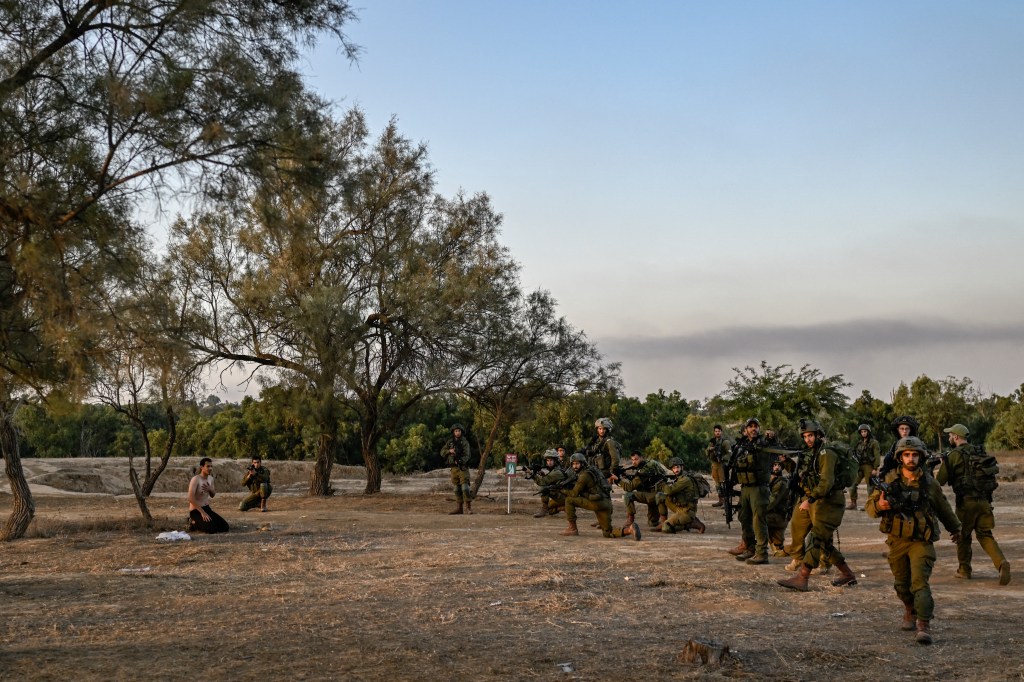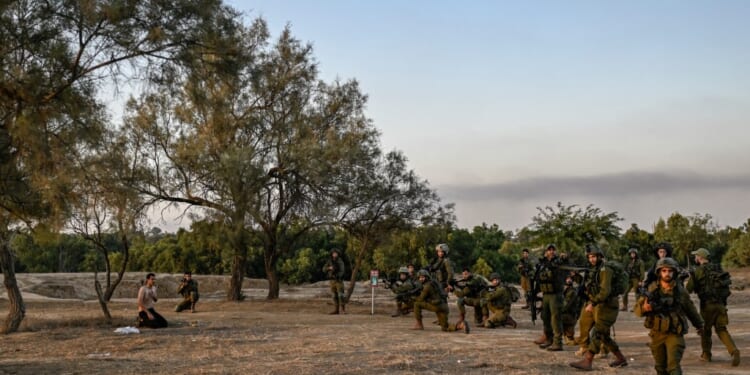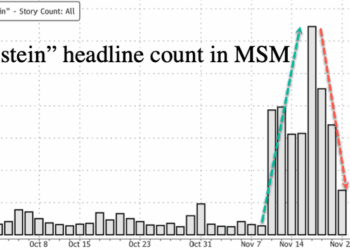
Nitzan Rahoum, 28, is heard shouting, “They took Lidor,” shortly after Lidor Levy, her fiancé and the father of her unborn baby, was gunned down. Rahoum was killed by what was believed to be a grenade blast in the shelter.
It’s been two years since the events of October 7, 2023, when Hamas terrorists broke through the Gaza-Israel barrier, attacking military bases and massacring civilians in 21 communities. Across southern Israel, including at the music festival—held near the Gaza border as a celebration of “friends, love and infinite freedom”—terrorists murdered more than 1,100 people, including 39 children. Three of those were toddlers. Rape was endemic. If their crimes weren’t caught on security cameras or recorded by people in hiding, the terrorists livestreamed and posted them.
And the deaths didn’t end on that day. Shirel Golan, who survived the Nova massacre, committed suicide a year later, the day she turned 22. The war that has followed since—as Israel attempts to take back its hostages and eliminate Hamas—has killed more than 400 Israeli soldiers, and tens of thousands of Palestinians.
“The fact that many innocents were deliberately targeted by Hamas, indeed have lost their lives, [been] hurt, kidnapped to Gaza—the youngest Israeli hostage kidnapped to Gaza among the 251 hostages was a 10-month-old baby—it threw Israeli society into shock,” Uri Weltmann—a national field organizer for Standing Together, a grassroots organization advocating for a ceasefire and hostage release deal—told TMD.
Two years later, the country is still trying to process and endure it. “It’s an ongoing event that is quite hard to process something which is still going on,” Amit Segal, chief political analyst of Israel’s N12 News and author of the “It’s Noon in Israel” newsletter, told TMD. “It’s not even that Israel is post-traumatic because the trauma is still here,” he added. “Half of the hostages [have] not been released yet, and the war is still going on, and there are still [military] casualties.”
The massacre and its aftermath have taken a major psychological toll on Israelis of all ages. A study conducted in the wake of October 7 found that as many as 84 percent of Israeli children suffer from emotional distress. Another study released in February, which examined the attack’s psychological impact on 858 Israelis three months after, concluded that “more than a third of the population was likely to meet at least one [mental health disorder] diagnosis three months after the onset of war activities,” including post-traumatic stress disorder (PTSD), anxiety, and depression, while only about 20 percent of subjects “experienced very low levels of distress and functional impairment.”
At the national level, the attack shattered the notion that Hamas could be deterred through economic incentives and other pressure points. And that newfound realization extended to the country’s other enemies, giving birth to the idea that adversaries had to be neutralized rather than simply managed. In the two years since October 7, Israel has gone on the offensive to significantly degrade the threats posed by terrorist groups Hamas, Hezbollah, the Houthis, and their key state backer, Iran. Yet Hamas’ continued control over Gaza—together with the 20 Israelis believed to be still alive and in terrorist captivity—is a daily reminder of the failures of that day.
They’re also reminders of the challenges Israel has confronted over the course of its Gaza bombing campaign and ground operations, which have yet to fully achieve the government’s main war aims: freeing the hostages and eliminating Hamas as a military and governing entity. But even so, IDF operations have all but hollowed out Hamas’ military leadership, including the group’s top commander, Mohammed Deif, in July 2024, and its leader in Gaza, Yahya Sinwar, in October 2024. More recently, Hamas confirmed the death of its lead propagandist, Abu Obaida, in targeted Israeli airstrikes on Gaza City.
Even outside of Gaza, the plotters of October 7 have not been safe from Israel’s reach. In July 2024, a bomb reportedly planted by Israeli operatives detonated in a guesthouse in Tehran, killing Ismail Haniyeh, Hamas’ top political leader, an operation that Israel in December 2024 acknowledged it had orchestrated. Earlier that year, a reported Israeli drone strike in Beirut killed Hamas’ deputy leader abroad, Saleh al-Arouri, who helped to plan—and even foreshadowed—the multifront war against Israel. Last month, Israel made the unprecedented move of striking a gathering of Hamas negotiators in Qatar’s capital city, Doha, an attack the group has said its senior officials survived.
On September 16, a United Nations commission completed a report that found that Israel’s military actions in Gaza amounted to genocide, which, per the commission’s chairman, Navi Pillay, was executed “with the specific intent to destroy the Palestinian group in Gaza.” However, some military experts, such as John Spencer, the chair of urban warfare studies at the Modern War Institute at West Point, said that Israel has taken unprecedented measures to avoid civilian casualties during wartime, writing in a March 2024 Newsweek article, “By my analysis, Israel has implemented more precautions to prevent civilian harm than any military in history—above and beyond what international law requires and more than the U.S. did in its wars in Iraq and Afghanistan.”
It’s also difficult to access accurate information from on the ground in Gaza, as nearly all public facilities—including hospitals—are overseen by Hamas, as are many news reports that use Hamas fighters for sourcing.
“It’s like reporting out of the Soviet Union or Nazi Germany,” Yehudah Mirsky, a professor of Near Eastern and Judaic studies at Brandeis University and a former State Department official, told TMD. “You can’t be critical about Hamas.”
One primary problem with accusing Israel of genocide, Mirsky continued, is that it doesn’t do anything to stop the fighting between Israel and Hamas. “It’s still puzzling to me, unless I’m being willfully naive, how it is that people don’t realize that the instantaneous piling on onto anything Israel does just gets Israelis’ backs up and doesn’t actually advance any goals.”
“So then Israelis just like, turn it off,” Mirsky added. “News consumers outside of Israel have been exposed to much more coverage of Palestinian civilian suffering in Gaza than Israeli news consumers have. That’s just a fact. And you know, frankly, I do think that’s a problem.”
From the onset of the war, Israeli Prime Minister Benjamin Netanyahu set two goals before deciding to wind down its military operations in Gaza, which, in addition to eliminating Hamas’ terror cell in the area, is “to do everything possible to bring our captives home.” To date, 146 have either been freed or released, and 20 hostages are believed to still be alive in Gaza.
Hamas’ leadership on Friday publicly agreed to the broad terms of President Donald Trump’s proposed 20-point ceasefire and full ceasefire release plan, so long as certain conditions are met, including “Arab and Islamic support” and assurances that governance of Gaza will be transferred to an independent Palestinian body. Specific terms of the plan, and the process for how the release of the remaining hostages will unfold, are yet to be determined, but the White House said it is hopeful of reaching a deal this week. Likewise, it remains unclear how Hamas would relinquish power to some as-yet-unformed government body, but Trump made clear to CNN news anchor Jake Tapper in a Sunday text message that, if the terrorist group attempts to keep a foothold in the Gaza Strip, it would be “complete obliteration!”

















